#niklas natt och dag
Explore tagged Tumblr posts
Text
Det träd kan inte vara ruttet som rest ett skott som du.
Ödet och hoppet, Niklas Natt och Dag
4 notes
·
View notes
Text
1793: Графічний роман

Homo homini lupus est
Дуже тішуся тому, що "Фабула" видала графічний роман українською. Тепер у мене є повна колекція серії "Бельман нуар" Нікласа Натт-о-Даґа.
І хоч сам автор скептично ставиться до екранізацій, надаючи перевагу ілюстраціям, мені здається, що рано чи пізно ми можемо дочекатися на фільм за мотивами його детективної серії про Швецію 18 сторіччя.
Графічний роман став моїм подарунком на ден�� народження. Мені дуже хотілося побачити візуалізацію головних героїв та знов відчути атмосферу кримінального Стокгольму та його таємниць.
Головною родзинкою графічного роману, звісно ж, є Сесіл. І хоч один з персонажів каже, що "красенем його не назвеш", хіба можна з цим погодитись?

Цей його розкішний червоний бант просто постріл у саме ❤️. Стиль художника прикрашає атмосферу оригінального роману, доповнюючи відчуття нуарності, похмурості та навіть чогось готичного.
Цей комікс є ідеальним доповненням до першої частини серії, що оживлює образи персонажів в уяві читача.
#укртумбочка#український tumblr#ukrainian tumblr#укртамблер#український тамблер#український блог#ukranian blog#книжковий блог#niklas natt och dag#cecil winge#bellman noir
4 notes
·
View notes
Text
La trilogía de Estocolmo (1793, 1794, 1795), de Niklas Natt och Dag
Hace un par de semanas acabé de leer 1795, la tercera parte de la Trilogía de Estocolmo. La primera parte de la trilogía, 1793, la leí allá por el 2020, así que finalmente he leído la trilogía más o menos a libro por año, según se han ido publicando (aunque con un poquillo de retraso, eso sí). Aunque debido a mi sequía bloguera no llegué a hacer reseña de 1793, ni de 1794, el segundo volumen,…
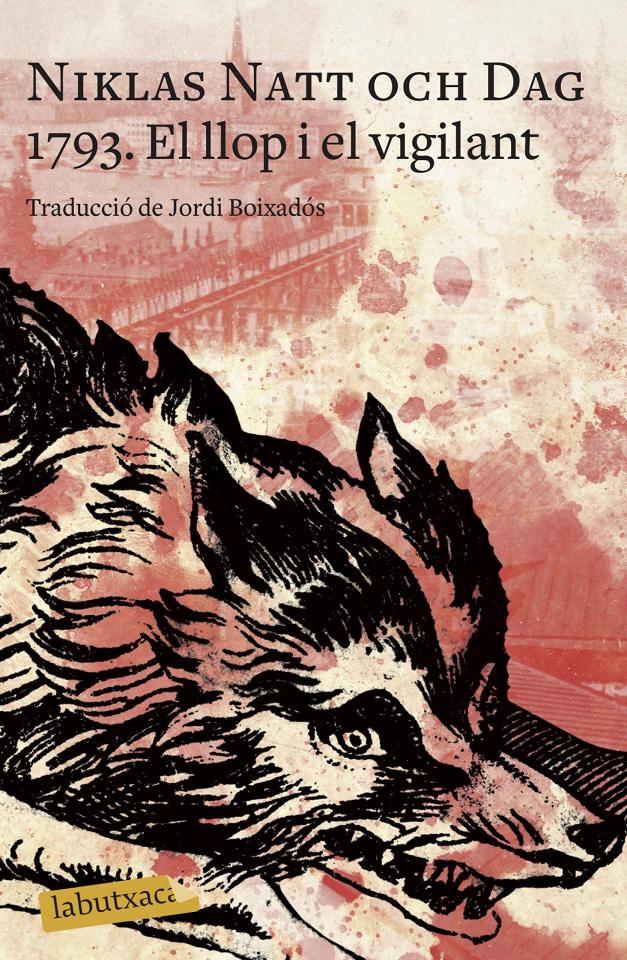
View On WordPress
0 notes
Text
Oh, what beautiful art! And I recognize the hands.
Seriously, 1793 is such a great book if you are into stories that are a bit darker. It is dark, has lots of twists and turns, two great main characters, is set in Stockholm towards the end of the 18th century – and there are two follow-up novels, 1794 and 1795 (although 1793 is by far the best book of the trilogy) …. so what is not to like?
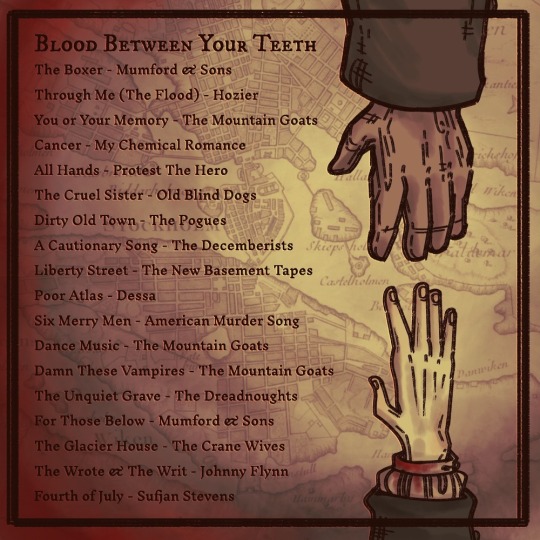
recently I've read a very meaty and murdery novel, and, since I haven't stopped thinking about it, now I've made a playlist about it.
[listen here]
#reblog#chiropteracupola#1793#1794#1795#books#cecil winge#jean michael cadell#history#niklas natt och dag#sweden#art
46 notes
·
View notes
Text
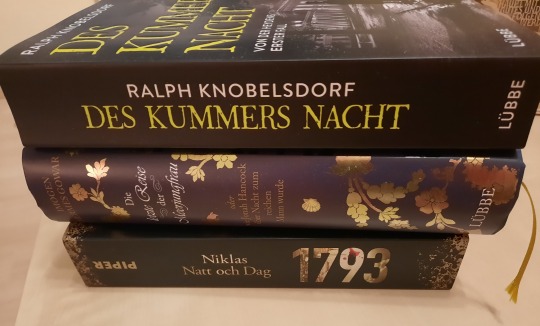
I was tagged by @clove-pinks, @my-deer-friend and @ouiouixmonami for the book thingy. :-) Thank you very much and apologies that it took me so long.
Last Read: 1793 by Niklas Natt och Dag. Probably never before have I re-read a book so quickly. After finishing the last book of the triology (1795) I had to read 1793 again because ... I had feelings after reading 1795.
Current Read: Die letzte Reise der Meerjungfrau by Imogen Hermes Gowar. This book is absolutly not what I usually read - but boy, this story is outstanding. "Realistic" fantasy set in 18th century London and characters that you have to love.
Next Read: So, I have the terrible habit of reading several books at the same time and therefor Des Kummers Nacht by Ralph Knobelsdorf is not the next book to begin but the next book that I actually intend to finish. :-)
Since I am so late to the party, I have no idea you has already done this and who not. If you have a great book that you want to share, feel yourself tagged by me.
8 notes
·
View notes
Text
I was tagged by @chiropteracupola, thank you!
last song: pretty sure it was “Children On Stun” by The March Violets
currently watching: I have one last episode to go of the most recent season of Yellowjackets and then I’ll be between things to watch (I have a very long To Watch List and so little time)
currently reading: currently bouncing around between Post Captain by Patrick O’Brian (as an audiobook, which I’m counting for the purposes of answering this question, and which means this has become my go-to Thing To Play At Work), The Wolf and the Watchman by Niklas Natt och Dag, and a re-read of For the Term of His Natural Life by Marcus Clarke
current obsession: I’m so good at being obsessed with things, let me see...both the Aubrey-Maturin series and For The Term of his Natural Life as far as media goes, also my current embroidery project, going out and looking at birds, and various history, medical, and medical history topics I’m always rotating in my mind (this isn’t all the obsessions just the ones I can remember right now)
I’ll tag @the-antlered-cryptid, @little-flame-prince @blindrapture @helensbridge @mg549 @maltusianscientist @crankyfemme, @herbertwest @nymm-of-night and if anyone else who sees this wants to join in please consider yourself tagged!
6 notes
·
View notes
Text
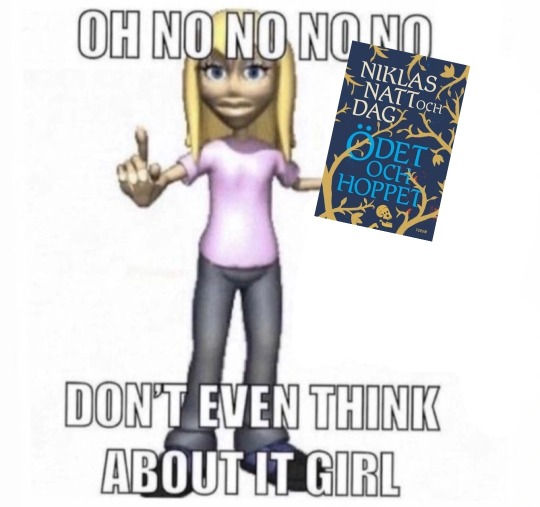
I got niklas natt och dags new book but i dont have time to read it as im in a bookcircle about another book i have to read and im going a little insane over that☝️
4 notes
·
View notes
Text
tagged by @chiropteracupola!! we will See how many books i can for real remember
rules: list ten books that have stayed with you in some way, don’t take but a few minutes, and don’t think too hard - they don’t have to be the “right” or “great” works, just the ones that have touched you.
1. The Rook - Daniel O’Malley: OUGHHH favorite book of all time and i’m not at All exaggerating. it is the pinnacle of literature to me, with a great balance of humor and drama and mystery and the supernatural and also the main character is sooooooooo. i cannot describe how insane in the head she makes me
2. Feel the Fear - Lauren Child: technically the Entire ruby redfort series lives in my brain rent free but the fourth one in particular ticks Every box to me. vintage cinema. circus performers. poetry. actual Lasting Consequences Of Trauma in a main character. skateboarding? idk it’s so fucking good and i think about it constantly
3. There, There - Tommy Orange: we had to read this for ap lit my senior year and i genuinely think about it So often its prose is so evocative and good to the brain and it Evokes such physicality and the turns of phrase are so cool and also it’s a really well structured story that’s clever and complicated (fun) and makes your heart hurt and i genuinely recommend it all the time
4. A Study in Scarlet - Arthur Conan Doyle: i feel like this one iiiiis self explanatory but also!! the platonic ideal of holmes and watson To Me!!! exuberant and young and jittery and two steps from shaking themselves apart and so full of love and adoration for each other!!!!! AUGH!!!!!
(and here is when i start forgetting books)
5. The True Lives of the Fabulous Killjoys: California - Gerard Way, Shaun Simon, & Becky Cloonan: comics of break your brain forever n ever n ever. full of sadness and beautiful art and lesbian robots and a Kitty (big kitty baby kitty evil kitty <3)
6. Animorphs - K. A. Applegate: books that i think about aaaaaall the time in some way because i love Meat in my sci-fi (y’all remember the allergic reaction to crocodile dna? because I DO)
7. The Wolf and the Watchman - Niklas Natt Och Dag: y’know what fuck it cecil winge and mickel cardell got real in my brain earlier this year so they get to join the list. due to there’s MEAT and DETECTIVES and PALPABLE HOMOEROTICISM (my best friends weird detective guys ough augh)
8. It Devours! - Joseph Fink & Jeffrey Cranor: noticing a theme here in that there is also Meat in this one. but also the story of something far bigger than you could ever comprehend Coming For You and the quiet dread of keeping something from your partner and carrying the burden alone and also sometimes relationships Don’t Work and that’s Fine (and also there is a massive worm)
9. Lord of the Flies - William Golding: another school read! me n my friends went Real Weird about this book at the ripe old age of thirteen. don’t remember much of it now other than Jack The Chorus Boy but i do remember having big feelings about it then
10. Treasure Island - Robert Louis Stevenson: for a Wildly different reason than em, because i don’t remember. anything? about it? read it for school when i was eleven or twelve and promptly lost all memory of the entire story BUT. i built a model ship for it for my final project and i think that jumpstarted the current Big Boat Feelings that i have some eight or nine years ago
tagging: @nico-demons, @firstmatedville, @wilhelmina-murray-harker, @natdrinkstea, and @haijinks :)
4 notes
·
View notes
Text

it was meant to be an art blog at first, but, being honest, it is not going to happen any time soon, so I'll just list the things I'm interested in and potentially can discuss, feel free to dm
Bellman Noir series by Niklas Natt och Dag
ACD and any other Sherlock Holmes
Dostoevsky
French and English literature (but very poorly)
Mozart
Soviet cinema
linguistics
1 note
·
View note
Text
1793, de Niklas Natt och Dag.
Un abogado tuberculoso, el sagaz e incorruptible Cecil Winge, se hace cargo de las pesquisas, pero el tiempo apremia: su salud es precaria, la monarquía hace aguas y las revueltas están a la orden del día. Winge y Cardell se verán inmersos en un mundo de truhanes y ladrones, ricos y pobres, piadosos y pecadores, mercenarios y meretrices… Poco tiene que ver la ciudad de Estocolmo actual con la…
0 notes
Text

Long nights indoors need chills to distract you from the chill. Choosing #Swedish#translation by Ebba Segerberg of Niklas Natt och Dag's wonderful #thriller 1794: The City Between the Bridges (The Wolf and the Watchman #2) via Atria Books is a reward. My #BookRecommendation: https://expendablemudge.blogspot.com/2023/08/1794-city-between-bridges-second-wolf.html
0 notes
Text
Liv söker liv. Människan lever inte väl tillsammans, men hon klarar sig inte ensam.
Ödet och hoppet, Niklas Natt och dag
2 notes
·
View notes
Text
"1795" Ніклас Натт-о-Даґ
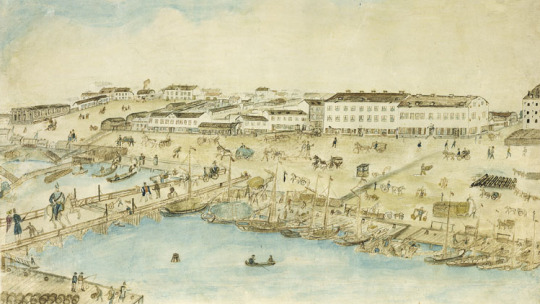
Нарешті я маю на руках ус�� серію. Знаю, що ще є видання у вигляді коміксу, але дуже сумніваюся, що воно колись з'явиться в Україні.
Ця книжкова серія - чи не найкраще читання за цей рік. За довгі роки. Вона напевне увійде у мій перелік найулюбленіших творів. Під час купівлі першої книги мені й на думку не спало, що зрештою ці книги принесуть мені таке задоволення.
Мені подобається похмура атмосфера старого Стокгольму, де поєднується розкіш та занепад, море та дощі, приреченість та надія, моральний розклад та гідність. Історичний Стокгольм змальований без екзальтованого піднесення, Ніклас Натт-о-Даґ фарбує його у сірі кольори. Сонячного світла цій історії додають зворушливі персонажі.
Й Сесіл, й Мікель, й Еміль, й Анна Стіна - всі вони багатогранні, захоплюючі, цікаві. Вони викликають співчуття та співпереживання. В кожному із них є щось, що доторкається до серця та думок. Шкода з ними розлучатися, але у 1795 році їхня історія добігає кінця. Й хоч всі вони заслужили на дрібку талану та щастя, випадуть вони лише на долю Анни Стіни.
Якщо я правильно зрозумів, Мікель вчинив самогубство. Його можна зрозуміти, але разом з ним, здається, померла надія на визволення Еміля.
Еміля шкода більше за всіх. Життя над ним й так познущалося, а скніти у божевільні до скону - це взагалі пекло ще за життя. Хочеться сподіватися, що якимсь чином йому вдасться знов втекти звідти. І хоча Сесіл, який допоміг йому минулого разу, вже мертвий, мені все одно кортить видумати якийсь щасливий випадок. Може написати фікс-іт?
Я досі під враженням від цієї серії. Вона неймовірна і неймовірно мене зворушила. Але дуже засмутила. Найбільше, звісно, засмутило нещастя Еміля. Він не заслуговує на це. Не розумію, чому Мікелю по��рібно було запроторити Еміля у божевільню, чому не виторгував йому забуття? Якщо вже він вирішив покінчити зі своїм життям, чому б просто не залишити Еміля на самого себе? Гадаю, Мікель добрими намірами вимостив дорогу до пекла. Можливо Булін його обдурив, не знаю. Навряд він розумів, що для Еміля майже неможливим буде втекти. І все одно... Трохи злюся на Мікеля. Врешті він виявився дійсно не дуже розумним, чи краще сказати обачним. Підставив єдину людину, яка його цінувала.
Одним словом, сумно. Мені дуже сподобалося читати цю серію, вона жодного разу не схибила у тому, щоб викликати почуття. Але на разі ці почуття сумні та неоднозначні. Не знаю, чи захочу коли-небудь перечитати ці книжки. Можливо. Але точно знаю, що якщо побачу у майбутньому новий твір Нікласа Натт-о-Даґа - точно придбаю та прочитаю.
#укртумбочка#український tumblr#ukrainian tumblr#книжковий блог#укртамблер#український тамблер#ukranian blog#український блог#український пост#book review#відгук на книгу#книгоблог#українською#укртумба#читацький блог#читання#книжкова полиця#1795#niklas natt och dag#the wolf and the watchman#ukrtumblr
1 note
·
View note
Text
1793, de Niklas Natt och Dag. Reseña
1793, de Niklas Natt och Dag, se publicó en 2017 y poco después la Academia Sueca de Novela Negra lo... http://dlvr.it/Sv36YC
0 notes
Note
i'm afraid i do not know what &c is but i am intrigued by tavern futures / lesbian handicrafts time
'this is my first the wolf and the watchman' fic', says the guy who swore so vehemently that they would write no fics for this book ever at all. as you can see, I have failed to follow through on that promise and am in fact writing Two now.
so I got absolutely knocked head-over-heels by the way that johanna makes her exit from the narrative of this book, and also by the end of it all was just very very tired of anna stina having nearly every awful thing that could possibly happen to her Happen. and thus I wanted to write something where 1) johanna is fine and 2) very few further tragical happenings occur and 3) as a treat for me they might even kiss about it. also because a few months ago I learned to spin yarn and now I am (as is usual) obsessed with applying Craft Skills I Learned into my fics.
so this is a story called Johanna Gets Out Of The Workhouse and this is a story called Where Else To Go Than The Safe Place You Made For Your Friend and this is a story called Taking The Skills You Used To Use For Keeping Yourself Alive And Using Them To Make The Future Better.
[also I'm going to go right ahead and pretend the sequels don't exist both for the sense of this fic and also just in general. I have a Foreboding that niklas natt och dag might be setting up for cardell/anna stina in the rest of the series and I have no interest in it*]
“Will you stop your fussing?” Johanna’s eyes glinted sharply, and Anna Stina was glad to see her friend’s familiar fire. So determined, as always, to have things her own way. ��I think I’ve earned the right to a bit of fussing,” she replied, pulling her shawl a little more closely around Johanna’s shoulders. “Living with Tulip has made you as silly as he is,” said Johanna, but there was more of a laugh to her voice than Anna Stina had ever heard in all those dark nights when Johanna had sat at the foot of her bed and measured out tales in exchange for new-spun string. Now it was Anna Stina who sat at the foot of the bed, thick new-bought stockings keeping her feet from the cold of the floorboards. Things were not as they had been before at all, at all, and she drew her feet up under her skirts, resting her heels against the bed-frame. “Come and sit with me,” said Johanna, her knees tucked close to her chest under the quilt. It was a faded old thing, worn at the corners where it had not yet been mended, but still thick and warm despite its age. Perhaps it had been the childhood blanket of the real Lovisa Ulrika Tulip — Anna Stina had not asked, for fear of shattering the fine layer of falsehood that still lay between her and her foster-father. But no matter the girl whose quilt it had been, for she was years gone from Stockholm, and had only entered into Anna Stina’s life by the empty space she had left behind. There was another such empty place at Johanna’s side, in that bed in the upper story of the Scapegrace that ought to have been hers and her erstwhile husband’s, and Anna Stina fitted herself into it neatly.
#em writes stuff#actually. would it hurt to maintag this. there are four maybe five people on this whole website who Care and one of them is me.#we are being confident today I think and I Will maintag that#the wolf and the watchman#so yeah. Family Of anna stina and her kid and her not-really-her-dad and her girlfriend who is both Okay and Present.#*if you have read 1794/1795 and thus Have Information then please Keep Me In The Dark About It. thankee.#OH YEAH AND the '&c' is just for things that it didn't feel worthwhile to sort into their own full sections. it's 'etc' basically.
10 notes
·
View notes
Text
1793, de Niklas Natt och Dag. Reseña
1793, de Niklas Natt och Dag, se publicó en 2017 y poco después la Academia Sueca de Novela Negra lo... http://dlvr.it/Sv36Wk
0 notes